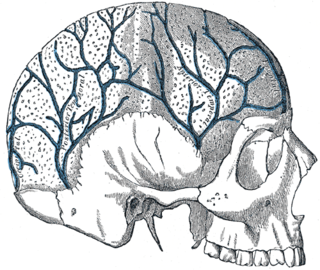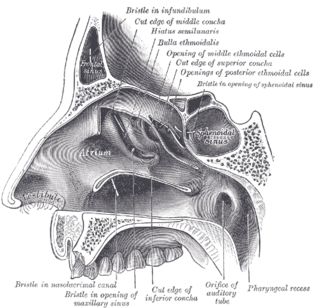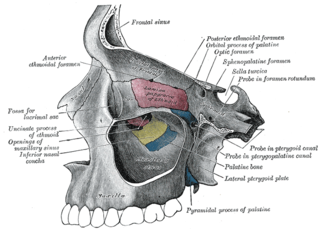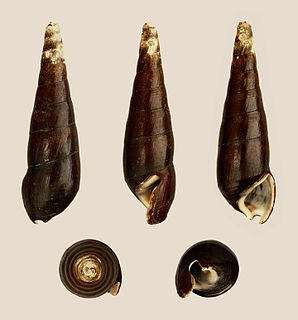
The diploic veins are large, thin-walled valveless veins that channel in the diploë between the inner and outer layers of the cortical bone in the skull. They are lined by a single layer of endothelium supported by elastic tissue. They develop fully by the age of two years. The diploic veins drain this area into the dural venous sinuses. The four major trunks of the diploic veins found on each side of the head are frontal, anterior temporal, posterior temporal, and occipital diploic veins. They tend to be symmetrical, with the same pattern of large veins on each side of the skull.

The sphenoid sinus is one of the four paired paranasal sinuses that is contained within the body of the sphenoid bone. The sphenoid sinuses vary in size and shape, and owing to the lateral displacement of the intervening septum, which may insert on the carotid canal, they are rarely symmetrical. They cannot be palpated during an extraoral examination.

The sphenoidal conchae are two thin, curved plates, situated at the anterior and lower part of the body of the sphenoid. An aperture of variable size exists in the anterior wall of each, and through this the sphenoidal sinus opens into the nasal cavity.

Below the bulla ethmoidalis, and partly hidden by the inferior end of the uncinate process of ethmoid bone, is the maxillary hiatus ; in a frontal section this opening is seen to be placed near the roof of the sinus. In the articulated skull this aperture is much reduced in size by the following bones: the uncinate process of the ethmoid above, the ethmoidal process of the inferior nasal concha below, the vertical part of the palatine behind, and a small part of the lacrimal above and in front; the sinus communicates with the middle meatus of the nose, generally by two small apertures left between the above-mentioned bones.
The Reudemannoceratidae are the ancestral and most primitive of the Discosorida, an order of cephalopods from the early Paleozoic. The Reudemannoceratidae produced generally medium-sized endogastric and almost straight shells with the siphuncle slightly ventral from the center.
Turnoceras is a genus of Devonian cephalopods belonging to the oncocerid family Nothoceratidae. Its shell is broadly expanding and exogastrically curved such that the flattened dorsum is on longitudinally concave side. Aperture unconstricted with no hyponomic sinus for the water jet funnel. siphuncle along the outer, ventral, side, with radial, plate-like actinosiphonate deposits occupying the interior.
Octamerella is an extinct genus of prehistoric nautiloids from the oncocerid family Hemiphragmoceratidae that lived in what is now Europe and North America during the Middle Silurian.
Hemiphragmoceratidae is a family of endogastrically brevconic oncocerids characterized by elaborately visored apertures in which the hyponomic sinus in mature specimens is on a spout-like process and there may be lateral and dorsal salients.. Shells are compressed with the apical portion curved and the anterior straight. Siphucles are nummuloideal with expanded spheroidal segments and continuously actinosiphonate interiors.

The Phragmoceratidae is a family of extinct nautiloid cephalopods from the Order Discosorida that lived during the latter part of the Silurian.
Mandaloceratidae is a family in the nautiloid cephalopod order Discosorida, from the Middle and Upper(?) Silurian characterized by short, essentially straight shells referred to as breviconic, typically with a faintly exogastric shape produced by the profile of the body chamber.
Strandoceras is a strongly curved cyrtogomphoceratid with a laterally compressed cross section from the middle and upper Ordovician of Northern Europe; Estonia, Norway, the U.K.
Pentameroceras is a straight to slightly exogastric breviconic oncocerid from the middle Silurian of North America and Europe belonging to the Trimeroceratidae.
Ophioceras is a genus of closely coiled tarphycerid nautiloid cephalopods, the sole representatives of the family Ophidioceratidae, characterized by an evolute shell with narrow, subrounded, annulated whorls and a subcentral siphuncle composed of thin connecting rings that show no evidence of layering. The mature body chamber is strongly divergent and is the longest proportionally of any tarphycerid. The aperture has a deep hyponomic sinus and ocular sinuses, and so resembles some lituitids.

Faunus ater is a species of brackish water snail with an operculum, an aquatic gastropod mollusk in the family Pachychilidae.
Grimsbyoceras is a nautiloid genus included in the Oncocerida order of the family Acleistoceratidae that lived during the Middle Devonian. They have been found in North America (Illinois) and central Europe.
Gonatocyrtoceras is a genus of oncocerid nautiloids belonging to the family Acleistoceratidae, that lived during the Middle Devonian. Gonatocyrtoceras is characterized by strongly curved, depressed, breviconic shells. Curvature is exogastric, meaning the lower, or ventral, side is convex in longitudinal profile. The aperture is without a hyponomic sinus. The siphuncle is small and subventral.
Geisonoceras is an extinct orthocerid genus named by Hyatt, 1884, and type for the Geisonoceratidae established by Zhuravleva in 1959.
Tetrameroceras is a genus of short, essentially straight, breviconic, nautiloid cephalopods from the middle and Upper Silurian of Europe and North America included in the oncocerid family Hemiphragmoceraidae.
Trimeroceras is a genus of straight oncocerid from the Middle and Upper Silurian of Europe, and type for the Trimeroceratidae. A principal character is the slit-like aperture with a hyponomic sinus for the water-jet funnel, and mid dorsal and dorsolateral sinuses.
Aletoceras is a genus of Oncocerida nautiloids from the middle Devonian of North America included in the family Brevicoceratidae.






